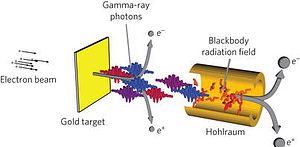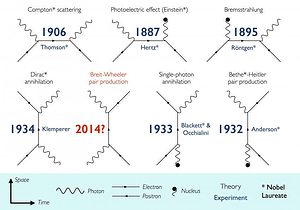Three physicists involved with fusion research have found an elegant way to convert light to matter. And, it can be accomplished with current technology. Demonstrating the process would round out a critical set of theories about energy and matter, so a race may soon be on to test it.
The Einstein relationship, E= mc2, states that energy and matter are equivalent and, therefore, interchangeable. We see this in nuclear reactions, where small amounts of matter release enormous energies, but going the other way – energy to matter – is harder because those energies have to be put back into the system.
A model to do just this, however, was proposed by Gregory Breit and John Wheeler in 1934. The American physicists theorized that forcing two photons together should yield an electron and its antimatter equivalent, a positron. That is, two particles without mass could create two particles with mass.
Oliver Pike, who’s completing his PhD in Plasma Physics at Imperial College London, said the Breit-Wheeler process was “the simplest way matter can be made from light” and one of the most elegant demonstrations of Einstein’s famous relationship.
The flexible hohlraum
While the physics community accepted the model as sound, Breit and Wheeler never thought that the idea would be achieved in the laboratory. But Pike and his colleagues, Professor Steven Rose (of the Imperial College Faculty of Natural Sciences) and Felix Mackenroth (a visiting theoretical physicist from the Max Planck Institute of Nuclear Physics) realized that a tool they were using in their own work – a hohlraum (German for “empty room”) – could also be applied to a direct test of the Breit-Wheeler theory. “Within a few hours of looking for applications of hohlraums outside their traditional role in fusion energy research, we were astonished to find they provided the perfect conditions for creating a photon collider.”
Their proposed process involves three steps:
1. Electrons are first accelerated to just below the speed of light with a high-energy laser, and then fired into a slab of gold to create a beam of photons a billion times more energetic than visible light
2. Another laser is fired at the inner surface of a gold vacuum container (the hohlraum) which emits another set of photons as blackbody radiation.
3. Finally, the photon beam is directed through the center of the chamber where photons from the two sources collide. The collisions should generate electrons and positrons when they exit the hohlraum.
The scientists recently detailed their method in Nature Photonics.
“We have shown in principle how you can make matter from light,” said Professor Rose. “If you do this experiment, you will be taking light and turning it into matter.” Calculations by the team showed that the equipment could squeeze enough particles of light, with high enough energies, into a small enough volume to create about 100,000 electron-positron pairs.
A simpler way
The conversion of photons to electrons and positrons was actually demonstrated in earlier research using the incredibly high energies of the Stanford Linear Accelerator. Because that work required the use of electrons to boost the photons to the required energy states, however, mass was involved at the beginning of the energy-to-mass conversion. The newly-proposed process combines the photons within the hohlraum chamber so any electrons stay outside. Any electrons that make it through the gold slab are filtered out by a magnetic field so the entire generating process is mass-free.
“Such a collider could be used to study fundamental physics with a very clean experimental setup: pure light goes in, matter comes out. The experiment would be the first demonstration of this,” Pike said.
The Breit-Wheeler model complements a set of theories about light-matter interaction, such as the photoelectric effect , and the creation of and destruction of matter and antimatter, work that has involved or produced nine Nobel laureates.
This process of creating matter from energy was critical in the first 100 seconds of the universe, and is seen today in gamma ray bursts, where photons are energized by high-energy electrons to form gamma rays during stellar explosions
After 80 years of theory, a practical way to convert mass from energy was published only this month. Now, researchers are hoping to build a machine that can demonstrate it within a year.
Events are accelerating toward the speed of light.











